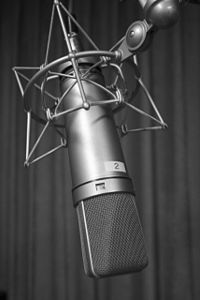
Neumann U87 microphone. Michael Rhys, Flickr. CC BY 2.0
What is digital humanities? Don’t ask: the first rule of digital humanities is don’t ask what digital humanities is. But the practice was alive and well at the 2013 annual meeting of the Oral History Association in Oklahoma City, driven by archivists’ use of digital technologies to strengthen and transform archival practice and oral historians’ creation of textured digital sources and tools to enable their use and engagement with the public. A Digital Humanities Interest Group revealed deep interest in reevaluating core practices-from creating new metadata standards to rethinking the transcript- and a crowd turned out for the University of Kentucky’s Doug Boyd’s demonstration of his Oral History Metadata Synchronizer (OHMS), a tool that connects transcript text with audio. “Making Oral History Public: The Media and the Movement Project and Digital and Traditional Outreach” suggested ways in which digital oral history can collapse boundaries between historians and the public as well as keep the interviewer-interviewee relationship alive after the conclusion of an interview. Dean Rehberger of Michigan State presented on the Oral History in the Digital Age project, and a research team from University of North Carolina’s Southern Oral History Program presented DH Press, an online digital toolkit, as well as Mapping the Long Women’s Movement, a multipurpose digital oral history project created with it.
Kelly Dent of Texas A&M-Commerce and her colleagues presented on Remixing Rural Texas, a project that remixes (not unlike music sampling) artifacts created for other purposes to tell a story in a different manner. The data source annotation tool provides users with information both about the remix itself and the artifacts. Robert Warren of the Illinois State Museum chaired a panel on the Audio-Video Barn, a website that features 300+ hours of recordings of interviews with people involved in agriculture and rural life in Illinois. To help website visitors find topics of interest within the, the AV Barn team developed a search mechanism that uses faceted clip browsing with a controlled vocabulary.
Oral history encourages interdisciplinary thinking, but it requires digital literacy, even if that just means operating a recorder. The complexity of the oral history-both text and audio, primary source and secondary source, a collaboratively created product- practically demands experimentation, and inevitably, the reflection that accompanies it. Look for lots more of both coming from the oral history community.
Seth Kotch is Digital Projects Director at the Southern Oral History Program.
This post first appeared on AHA Today.
Tags: AHA Today Digital History
Comment
Please read our commenting and letters policy before submitting.






